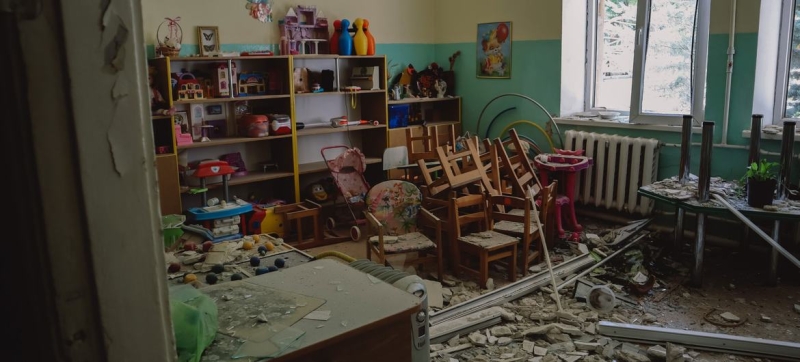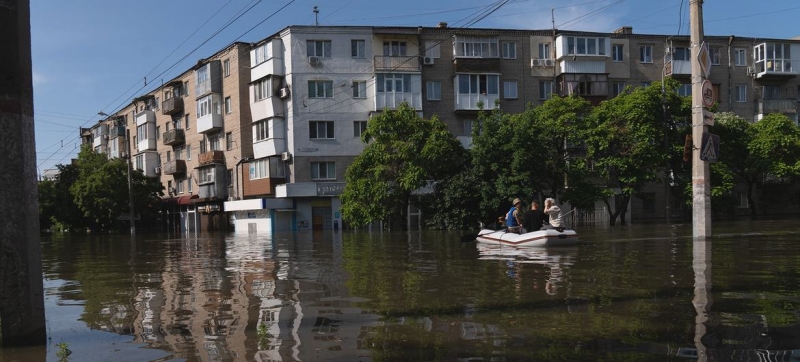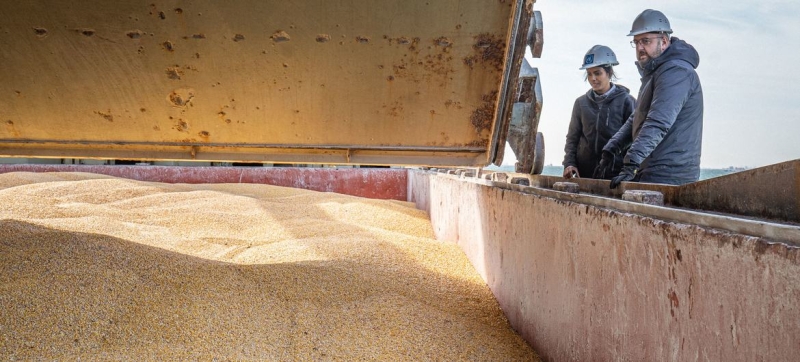
A destroyed Odessa kindergarten after Russian shelling in July 2023. Ukraine: another year of war Peace and Security
Today marks exactly two years since the start of Russia’s full-scale invasion of Ukraine. As a result of the war, at least 10,582 civilians were killed and 19,875 were injured, according to the UN. Throughout Ukraine, civilian infrastructure has been destroyed and damaged: residential buildings, hospitals, schools, energy facilities. The country’s economy is in ruins.
The second year of the war was marked by events such as the destruction of the Kakhovka Dam and Russia’s decision to withdraw from the Black Sea Grain Initiative. At the turn of 2023 and 2024, Russia stepped up attacks on Ukrainian territory, once again raising fears about the possibility of further escalation of the conflict.
Destruction of the Kakhovskaya HPP dam
The destruction of the Kakhovka hydroelectric dam is likely the most significant incident causing damage to civilian infrastructure since the Russian invasion of Ukraine began. UN Emergency Relief Coordinator Martin Griffiths stated this, speaking at an emergency meeting of the Security Council on June 6, 2023, convened to discuss the situation around the Kakhovka hydroelectric station.
Elimination of consequences and assistance to victims
UN humanitarian agencies, Griffiths said, stepped up their activities on the first day to eliminate the consequences of the accident and help the victims.
Many people were forced to leave their homes to escape flooding caused by a dam failure. At train stations and other places, UN humanitarian agencies organized special points where people could receive the necessary help and information.
The population of the flooded areas was provided with drinking water, cash, food, and basic necessities.
A catastrophe of colossal proportions
On the day of the accident, UN Secretary-General Antonio Guterres addressed reporters at a press conference at the headquarters of the world organization in New York. He called the emergency at the Kakhovka hydroelectric power station a “humanitarian, economic and environmental disaster” of colossal proportions, as well as “another devastating consequence of the Russian invasion of Ukraine.”

Flooded area of Kherson.
“Massive flooding. Large-scale evacuations. Ecological devastation. Destruction of newly planted crops,” the UN chief said.
“Attacks on civilians and critical civilian infrastructure must stop,” he added.
Nuclear threat
One of the most A serious consequence of the accident was a decrease in the water level in the Kakhovka reservoir: this water is used to cool the reactors of the Zaporozhye Nuclear Power Plant. Experts from the International Atomic Energy Agency (IAEA) who were there closely monitored the situation. Immediately after the collapse of the dam, the head of the agency, Mariano Grossi, visited the Zaporizhia NPP.
“Now more than ever, a strengthened IAEA presence at the Zaporozhye nuclear power plant is critical to preventing a nuclear accident and its possible consequences for people and the environment,” he said.
To find alternative sources of water to cool the reactors and spent fuel, 11 underground wells were eventually drilled at the plant. During his last visit to the plant in February 2024, Grossi said that the plant currently has enough water, “but this is not the final solution to the problem.”
Damage from the destruction of the dam – 14 billion dollars
By mid-October 2023, the UN, the World Bank, the European Union and the government of Ukraine have prepared report on the damage from the destruction of the Kakhovskaya hydroelectric power station dam: according to experts, it amounted to almost 14 billion dollars.
The dam failure led to the flooding of 620 square kilometers of territory in four regions – Kherson, Nikolaev, Dnepropetrovsk and Zaporozhye – directly affecting 100,000 local residents. The flooding severely damaged housing, infrastructure, the environment and cultural sites such as historical buildings and museums.
In addition, energy supply, water supply, agricultural irrigation and river transport in southern Ukraine were disrupted. Experts’ greatest concern is the long-term impact of the accident on the environment. The destruction of the dam reportedly led to massive deaths of fish and animals, destruction of ecosystems and agricultural lands, and shallowing of water bodies.
In February 2024, the UN and partners also calculated how much money would be needed to restore the economy and infrastructure of Ukraine as a whole over the next 10 years: $486 billion. By comparison, at the end of last year the cost of rebuilding the country was estimated at $411 billion.
Russia’s withdrawal from the Black Sea Initiative
On July 17, 2023, Russia withdrew from the Black Sea Grain Initiative. The UN Secretary-General said he “deeply regrets” the Russian Federation’s decision to terminate the implementation of the agreement, including withdrawing guarantees for the safety of navigation in the northwestern part of the Black Sea.
Consequences of Russia’s withdrawal from the deal
This initiative, according to Guterres, ensured the safe export of more than 32 million tons of goods from Ukrainian ports. The UN World Food Program (WFP) exported more than 725,000 tonnes of food to support humanitarian efforts that prevented famine in Afghanistan, the Horn of Africa and Yemen.
By deciding to withdraw from the Black Sea Initiative, the Russian Federation also ended its commitment to “facilitate the unimpeded export of food, sunflower oil and fertilizers from Ukrainian-controlled Black Sea ports,” as stated in the Memorandum of Understanding between the Russian Federation and the United Nations.

Inspection within the framework of the Black Sea Grain Initiative.
“Ultimately, participation in these agreements is [a country’s] choice,” Guterres acknowledged, “but people who struggle to survive and developing countries have no choice. Hundreds of millions of people face hunger and consumers face a global cost of living crisis.” These people will have to pay for Russia’s decision to stop implementing the initiative, the UN head warned.
Russia’s withdrawal from the deal was followed by attacks on port facilities and grain storage facilities in Ukraine. The Russian attacks have catastrophic consequences for both the people of Ukraine and the 345 million people suffering from hunger around the world, UN humanitarian coordinator for Ukraine Denise Brown said on September 13. She recalled that international humanitarian law strictly prohibits attacks on civilian infrastructure. “This has to stop,” Brown said.
Ukraine, meanwhile, began to use alternative routes for exporting its grain products, although it faced a number of obstacles.
Attempts to revive the initiative
After the decision Russia to terminate its participation in the deal, the head of the UN made attempts to revive the initiative. In particular, he sent a letter to Russian Foreign Minister Sergei Lavrov, in which, according to Guterres, “concrete proposals” were presented for its resumption.
The Russian authorities said that the Secretary General’s proposals would not work because they were not feasible. However, during his speech at the high-level week of the UN General Assembly, the Secretary General said that he would not abandon efforts to ensure access for Ukrainian food and Russian food and fertilizers to world markets.
According to reports, the Russian side continues to maintain contacts with the UN Secretary General and the head of the UN Conference on Trade and Development (UNCTAD) Rebekah Greenspan and discuss options for resolving the problem.
“Winter Attacks”
In Winter In 2023-2024, Russian attacks on Ukrainian territory intensified. Wave after wave of attacks hit Ukrainian cities. The UN noted a sharp increase in the number of civilian casualties.
The UN calls such attacks “winter attacks” because they do more than just bring death and destruction. During the cold season, attacks on civilian facilities have particularly severe consequences for the population: due to damage to infrastructure, people are left without central heating, hot water and electricity, which, among other things, deprives them of the ability to heat their premises with electric heaters. At the same time, in January of this year, the air temperature in some cities of Ukraine dropped below –15 degrees Celsius.
“It’s very cold here. We brought clothes, mattresses, blankets, solar lamps, and basic necessities. We are delivering all this to frontline settlements in Ukraine so that people can stay in their homes during what promises to be a difficult winter,” said UN Coordinator in Ukraine Denise Brown during her trip to Kupyansk in late December.
Read also:
INTERVIEW | Winter has aggravated the suffering of the inhabitants of Ukraine
At the beginning of 2024, the UN also noted that the radius of cross-border strikes is expanding on Russian territory and goes beyond areas immediately adjacent to the border.
As the leadership of the world organization emphasizes, so far there are no prospects for ending the war. But still, the UN does not lose hope and continues to recall the provisions of the UN Charter: “All Members of the United Nations shall resolve their international disputes by peaceful means in such a way as not to jeopardize international peace and security and justice.”
Addressing the participants of the Munich Security Conference on February 18, the head emphasized: “There is no alternative to a diplomatic settlement.”
